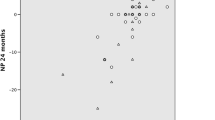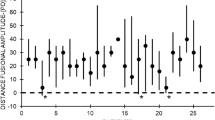Abstract
Background
As therapy with bifocal lenses can generate a condition of acquired hypo-accommodation, we assessed the results of bifocal therapy in children with non-refractive accommodative esotropia in whom near point of accommodation (NPA) was measured before the prescription of the lenses and at the end of the study.
Methods
We examined 28 consecutive patients orthophoric for far, but with esotropia due to excess convergence for near (group 1), and 28 matched controls, orthophoric for far and near (group 2). The patients were prescribed bifocal lenses between the age of 5 and 8. The NPA was measured at time zero and after 4 years of follow-up in both groups.
Results
NPA values, measured at time 0, were lower than average (10 dioptres) in ten of the 28 patients in group 1, and increased over the 4 years of follow-up without exceeding 10 dioptres. Only one of the other 18 patients in group 1, with normal NPA, had a lower value at the end of the study, although the values were still above 10 dioptres.
Conclusions
In several patients, excessive convergence is secondary to the extra accommodative effort required due to the presence of a primitive NPA deficit. In these subjects, the prognosis can be made on the basis of NPA measurement, and treatment with bifocal lenses will always be required to compensate. Furthermore, the parents of these small patients should be informed, even before the prescription of bifocals, that prospective surgery of medial rectus muscles will not eliminate the need for bifocals.


Similar content being viewed by others
References
von Noorden GK, Campos EC (2002) Binocular Vision and Ocular Motility: Theory and Management of Strabismus, 6th edn. Mosby, St Louis
Parks MM (1958) Abnormal accommodative convergence in squint. Arch Ophthalmol 59:364–380
von Noorden GK, Avilla CW (1986) Non-accommodative convergence excess. Am J Ophthalmol 101:70–73
von Noorden GK, Morris J, Edelman P (1978) Efficacy of bifocals in the treatment of accommodative esotropia. Am J Ophthalmol 85:830–834
von Noorden GK, Campos EC (2004) Patching regimens. Ophthalmology 111:1063, author reply 1064-1066
North RV, Kelly ME (1987) A review of the uses and adverse effects of topical administration of atropine. Ophthalmic Physiol Opt 7:109–114
Arnold RW, Gionet E, Hickel J, Owen M, Armitage MD (2004) Duration and effect of single-dose atropine: paralysis of accommodation in penalization treatment of functional amblyopia. Binocul Vis Strabismus Q 19:81–86
Avetisov ES, Kashchenko TP (1980) Method of increasing the dissociation between accommodation and convergence in treating concomitant strabismus. Vestn Oftalmol (2):16–21
Ponomareva SV, Sominskaia MS, Tumanian SA, Cheshko VN (1980) Effect of exercises for increasing the dissociation between accommodation and convergence on the state of accommodative and fusion convergence. Vestn Oftalmol (1):49–53
Leitch RJ, Burke JP, Strachan IM (1990) Convergence excess esotropia treated surgically with fadenoperation and medial rectus muscle recessions. Br J Ophthalmol 74:278–279
Millicent M, Perterseim W, Bickley EG (1997) Medial rectus fadenoperation for esotropia only at near fixation. J AAPOS 1:129–133
Stärk N, Vanselow K, Stahl E, Zubcov AA (1999) Retroequatorial myopexy combined with bimedial recession for near-distance disparity esotropia. Ophthalmologe 96:513–521
Steffen H, Auffarth GU, Kolling GH (1998) Posterior fixation suture and convergence excess esotropia. Strabismus 6:117–126
Breinin GM, Chin NB, Ripps H (1996) A rationale for therapy of accommodative strabismus. Am J Ophthalmol 61:1030–1037
von Noorden GK, Morris J, Edelman P (1978) Efficacy of bifocals in the treatment off accommodative esotropia. Am J Ophthalmol 85:830–834
von Noorden GK, Jenkins R (1995) Accommodative amplitude in children wearing bifocals. In: Lennerstrand G (ed) Up-date on strabismus and paediatric ophthalmology. Proceedings of the 7th Meeting of the ISA and 20th Meeting of the AAPOS. CRC Press, Boca Raton, p 201
Costenbader FD, Albert DG (1958) The management of strabismus. Pediatr Clin North Am 5:153–168
Costenbader FD (1958) Clinical course and management of esotropia. In: Allen JH (ed) Strabismus Ophthalmic symposium II. Mosby, St Louis, p 331
Mühlendyck H (1985) Symptoms and treatment in hypoaccommodation cases. In: Nemet P, Weiss JB (eds). International Symposium on Strabismus and Amblyopia. Acta Strabologica. Tel Aviv, CERES 25.
Mühlendyck H, Goerdt J (1996) Effect of bifocals on accommodation rate in hypoaccommodatives. In: Spiritus M (ed) Transactions of the 22nd Meeting of the ESA. Aeolus Press, Buren, The Netherlands, p 101
Bland JM, Altman DG (1986) Statistical methods for assessing agreement between two methods of clinical measurement. Lancet 8:307–310
von Noorden GK, Avilla CW (1986) Nonaccommodative convergence excess. Am J Ophthalmol 101:70–73
von Noorden GK, Munoz M (1988) Recurrent esotropia. J Pediatr Ophthalmol Strabismus 25:275–279
von Noorden GK, Brown DJ, Parks M (1973) Associated convergence and accommodative insufficiency. Doc Ophthalmol 34:393–403
Acknowledgement
This work was funded in part by a grant from the “Fondazione Cassa di Risparmio in Bologna”.
Author information
Authors and Affiliations
Corresponding author
Additional information
The study was performed in accordance with the ethical standards laid down in the 1964 Declaration of Helsinki. All persons gave their informed consent prior to their inclusion in the study.
Conflict of interest
The authors declare no conflict of interest.
Rights and permissions
About this article
Cite this article
Fresina, M., Schiavi, C. & Campos, E.C. Do bifocals reduce accommodative amplitude in convergence excess esotropia?. Graefes Arch Clin Exp Ophthalmol 248, 1501–1505 (2010). https://doi.org/10.1007/s00417-010-1418-6
Received:
Revised:
Accepted:
Published:
Issue Date:
DOI: https://doi.org/10.1007/s00417-010-1418-6




